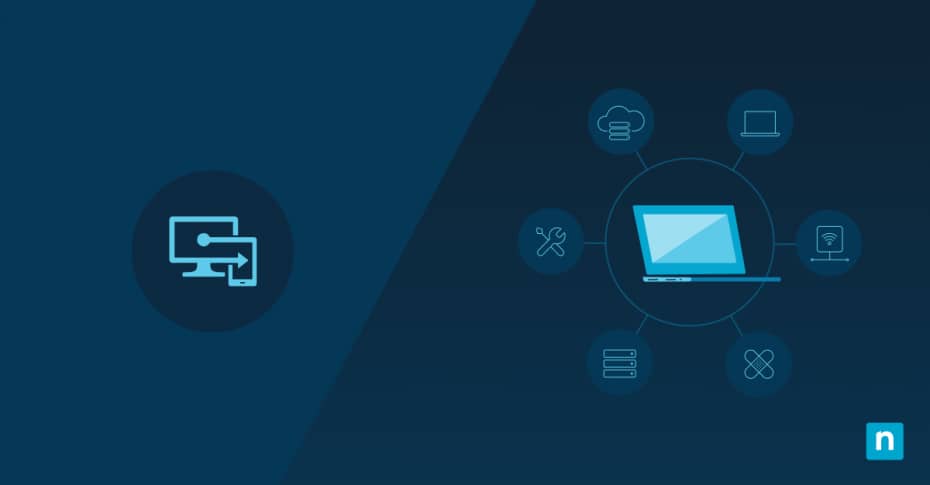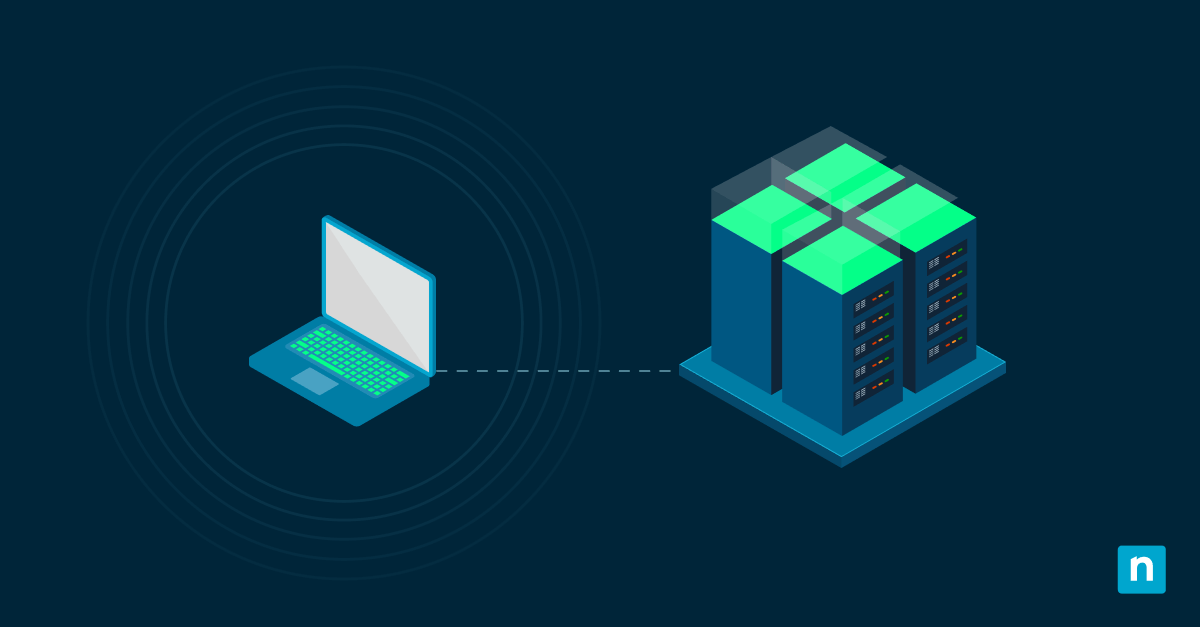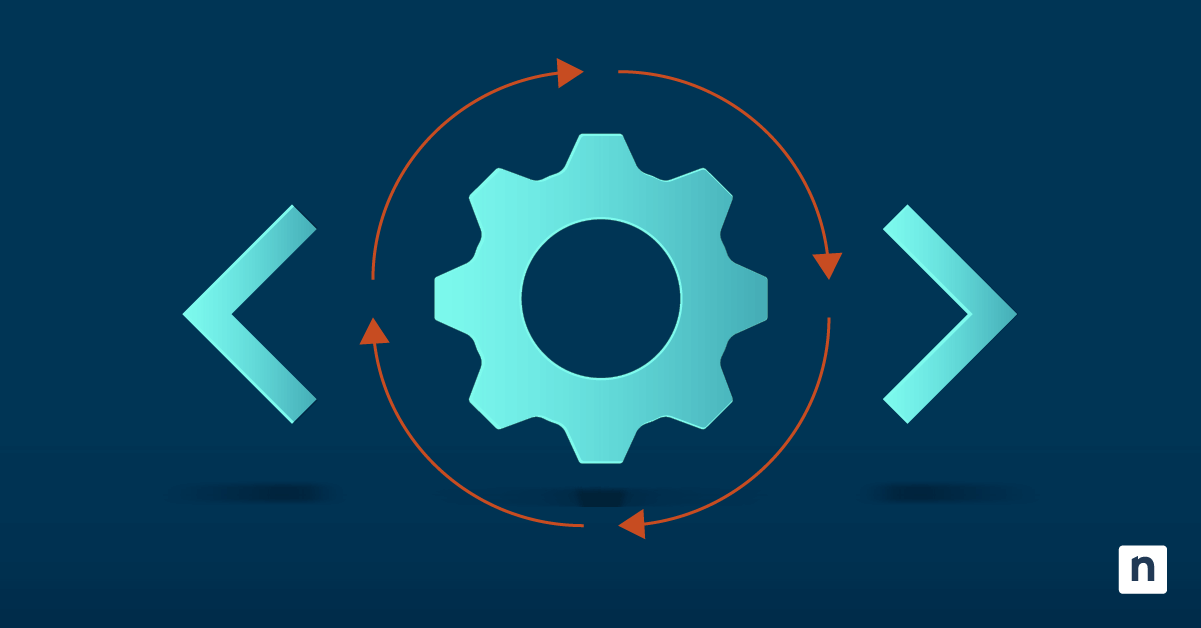Key Points
- Microsoft Intune is a cloud-based MDM tool that focuses on endpoint security, policy enforcement, and device configuration.
- Microsoft Intune is not an RMM. It lacks full remote control, multi-tenancy, and cross-platform features typically found in RMM solutions, so it’s not a true RMM substitute.
- Microsoft Intune is good for mobile management but less flexible for multi-OS fleets. It integrates with Microsoft ecosystems and offers strong device onboarding.
It’s common for an MSP to question the value of Microsoft Intune managing their customers. A few common concerns tend to come up, including the pricing structure and the lack of multi-tenancy. It’s also something new that the MSP and their staff may need to learn.
With that said, is MS Intune bringing value to the MSP’s table? Is there some potential to be leveraged out of using Microsoft’s MDM as a managed service provider? In this article, we’ll talk about the product itself, how MSPs integrate Intune into their stacks, and give the final verdict on Intune vs RMM.
NinjaOne MDM is a natural extension of its #1 endpoint management platform.
Download this essential guide to learn more.
What is Microsoft Intune?
Microsoft Intune is Microsoft’s proprietary SaaS solution. It is a cloud-based desktop and mobile device management (MDM) tool that currently supports MacOS, iOS, Android, and Windows 10. Intune started out as an enterprise-level management tool but has become heavily used by SMBs in recent years.
Intune is a cloud-based solution that enables MDM and mobile application management — meaning it’s used to control how devices are utilized and enforce policies that allow IT professionals to keep devices and the network secure. The app actually focuses heavily on configurations and features that improve endpoint security.
Intune also helps users set up laptops and mobile devices by automatically deploying and enforcing device configurations across a large number of individual installs. In total, Intune works for device onboarding, configuration, and administration for highly homogeneous environments and device configurations.
Noteworthy Intune features:
- Autopilot deployments
- Device provisioning
- Automated RMM deployment
- Microsoft Defender deployment and management
- Policy enforcement on end-users and devices (standard lockdowns on accounts, expiries, screensaver lockouts)
- Microsoft Office configurations
Is Microsoft Intune an RMM?
Microsoft Intune focuses more on endpoint management. While it shares some overlap in functionality, such as the ability to manage devices remotely, RMM software offers more powerful features that allow IT teams to manage assets across multiple operating systems and manage multiple clients under a single account.
Can Microsoft Intune replace an RMM tool?
Microsoft Intune is not a proper replacement for an RMM tool, such as the one offered by NinjaOne. Intune lacks some key features that an RMM tool can provide such as remote control, native multi-tenancy, greater flexibility, and more support for non-Microsoft products.
Why Microsoft Intune can’t replace RMM software
-
Missing remote control features
Reviews of Intune have mentioned how its remote control capabilities are not as complete as that of an RMM software. In fact, Microsoft offers multiple remote access tools but each one has limited features such as file transfer only being available for its Remote Control tool but not its InTune Suite Remote Help tool.
-
Single tenant
The subscription and all associated data are locked inside a single tenant — a major problem for managed service providers. There is currently no way for a service provider to monitor and manage multiple customers/subscriptions. If you’re trying to manage 100 clients, it means logging into 100 different Intune accounts (a common thread among MS Office services in general).
-
Lacks cross-platform support
Originally built for Microsoft-exclusive IT infrastructure, While Intune provides robust endpoint management within the Microsoft ecosystem, its support for non-Microsoft endpoint devices and networks is limited. This can be problematic for organizations using a diverse range of operating systems and devices.
-
Limited monitoring tools
Intune’s monitoring capabilities can be limited compared to an RMM software that can offer more extensive monitoring tools that can provide immediate insights into system performance and security vulnerabilities.
-
Policy management
Intune’s policy management utilizes GPO (Group Policy Objects) for IT administrators to deploy policies to set groups. While it allows for broad policy enforcement, fine-tuned control over specific configurations or patching is not as granular as an RMM solution. RMM software is capable of enforcing policies at scale but also enacting specific scripts for individual endpoint devices.
Microsoft Intune pros and cons
Microsoft Intune pros
What is the upside of using MS Intune? Let’s take a closer look.
-
Conditional access
Privilege access control is a critical part of IT security. Intune allows you to set accessibility rules that help keep people with lower levels of security from accidentally using unsafe devices to access important resources. Conditional access and privilege access control are also important components of certain compliance requirements.
-
Zero-touch deployment
Zero-touch deployment allows MSPs to ship ready-to-go devices to customers and save a significant amount of time when onboarding.
-
Mobile features
Intune brings mobile device features that supplement a lot of MDM features in RMM solutions. One useful example is the ability to easily and quickly separate personal and company data on devices. This feature alone can be invaluable in a number of different privacy and security scenarios.
-
Device flexibility
Intune can manage many different ownership and usage configurations. As an example, Android mobile devices can be managed under BYOD (Bring Your Own Device), CYOD (Choose Your Own Device), COBO (Corporately Owned, Business Only), and COPE (Corporately Owned, Personally Enabled) models.
Microsoft Intune cons
What challenges come with using Intune? Here are some common bits of MSP-specific feedback:
-
Difficult to use
Intune itself can be challenging to use, especially if the MSP hasn’t been formally trained on the use of the product. Either training/reviewing documentation is recommended prior to using SCCM.
-
Finicky remote options
Even though the remote assistance features in SCCM are really good, it can be challenging at times when the remote options don’t work for a particular endpoint. Troubleshooting the remote options can also prove to be a challenge.
-
Single tenant
The subscription and all associated data are locked inside a single tenant — a major problem for managed service providers. There is currently no way for a service provider to monitor and manage multiple customers/subscriptions. If you’re trying to manage 100 clients, it means logging into 100 different Intune accounts (a common thread among MS Office services in general).
-
Pricing
The price of a per-device license for Microsoft Intune has many users turning toward competing MDMs. It can be costly, especially for MSPs who need to convince smaller businesses that a noticeable increase in their pricing is worth the squeeze. It’s always a wise idea to research MDM pricing and how it aligns with your current IT budget.
Is Microsoft Intune a good MDM?
While it’s becoming clear why Intune won’t serve as an RMM replacement, how does it hold up as an MDM system? That is its designed role, after all.
Probably the most obvious advantage offered by Microsoft Intune is its integration with existing services that you’re probably already selling to your clients.
The software offers sufficient configurations for effectively managing every aspect of devices in your client base. As you would expect, you can control who uses them, and how, to what apps are installed, how they’re used, and various security settings.
Configuration profiles are used to populate these settings, with different profiles available for various devices and platforms. Profiles can be easily applied to devices individually or in a group with Microsoft Intune.
Intune also features identity protection, Wi-Fi and VPN profiles, multi-user device management, and preference files for macOS. The Windows and macOS library contains settings that can be configured in one easy-to-access location.
There are quite a few MDMs to choose from, and you may be immediately intrigued by Microsoft’s proprietary offering, or that might be enough to dissuade you. All things considered, Intune does boast wide compatibility for mobile platforms, a cloud-based management console, and device enrollment that ranges from simple to in-depth.
Discover the 10 best MDM software tools based on real user reviews.
What is Microsoft Intune Suite?
Microsoft Intune Suite is an advanced set of cloud-based tools for managing and securing devices, applications, and data. It is a series of add-ons for InTune that offer more options for MDM, remote access, and endpoint security. While InTune Suite offers powerful features, they have more specific applications that might not be as necessary for all businesses or MSPs.
In addition, since each capability offered by InTune Suite is a separate add-on, it can be more cost-effective to manage devices using comprehensive software that includes RMM and MDM.
RMM vs MDM – What’s a better Intune alternative?
If you’re looking for a Microsoft Intune alternative or a solution that can compliment its feature, you might be wondering whether MDM or RMM software would benefit your business more. Look around the internet and you’ll find plenty of questions surrounding the “MDM vs. RMM” topic. Finding the answer begins by understanding the differences between these tools and where their limitations come into play.
🥷 Manage, support, and secure all your mobile devices in one powerful solution.
Schedule your 14-day free trial today.
The primary difference between these software solutions is that MDM focuses on managing mobile devices while RMM solutions are intended to be comprehensive. RMM tools are so multi-use that many RMM solutions include their own MDM functionalities. Still, there are reasons why your business may benefit more from a specialized MDM solution than an extensive RMM.
That said, one of the major flaws of using Intune as an RMM replacement lies in its lack of multitenancy. Having to manage a unique account for each user is untenable for an MSP with any hope of growing and scaling. The single dashboard benefit of a solid RMM tool instantly knocks Intune out of the running.
How NinjaOne can work with Microsoft Intune
All-in-one RMMs like NinjaOne take it one step further, providing a single dashboard that helps MSPs collect better customer data and avoid wasted time spent toggling between software. By providing easy, complete visibility into their clients’ systems, all-in-one remote monitoring and management options are the best tool for the job.
NinjaOne is a cloud-native comprehensive RMM software with powerful MDM capabilities that consolidates visibility and control of all endpoint devices into a single pane of glass. RMM tools like NinjaOne can work together with Intune, giving you Microsoft-native device administration capabilities for mobile devices alongside the proactive device support and infrastructure management capabilities in NinjaOne.
Thousands of our MSP partners use NinjaOne and Intune together for a more unified endpoint management experience.
Conclusion: Intune MDM or RMM?
Intune is billed by Microsoft as a mobile device management (MDM) solution, but their definition is broad enough to include devices like laptops and desktops. Because Intune brings mobile device features that mimic a lot of MDM features you’d find in RMM solutions, MSPs often wonder if they can replace their RMM with Intune.
As we’ve learned, Intune by itself isn’t quite enough. While it’s not a replacement for an RMM solution, Intune can work with next-gen RMM tools like NinjaOne to provide a comprehensive MDM experience that’s designed for MSPs.
NinjaOne MDM is a robust solution that allows you to conveniently and efficiently manage all your endpoints from a single console to reduce complexity and cost. If you’re ready, request a free quote, sign up for a 14-day free trial, or watch a demo.







